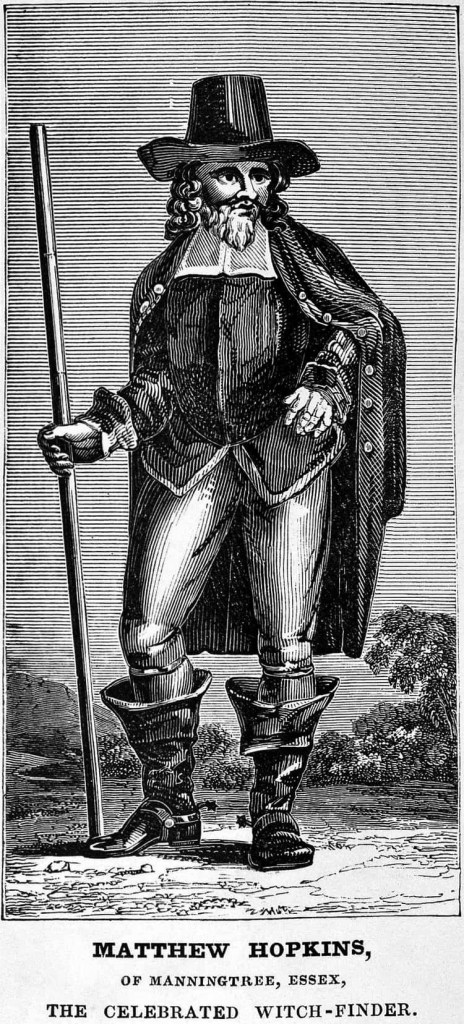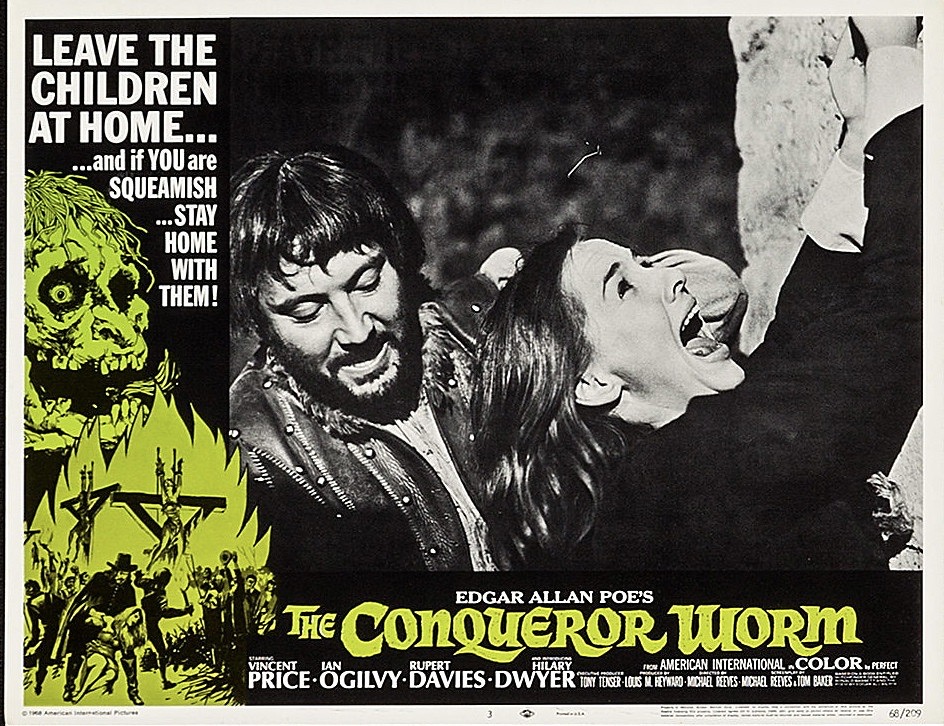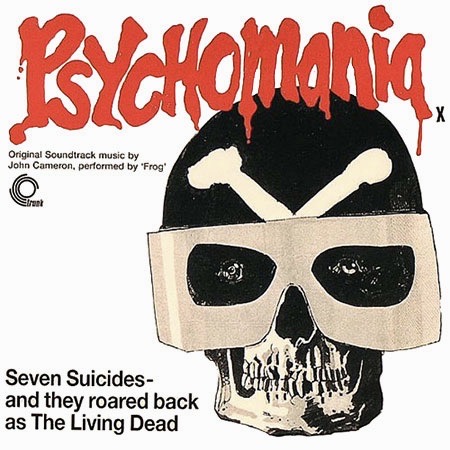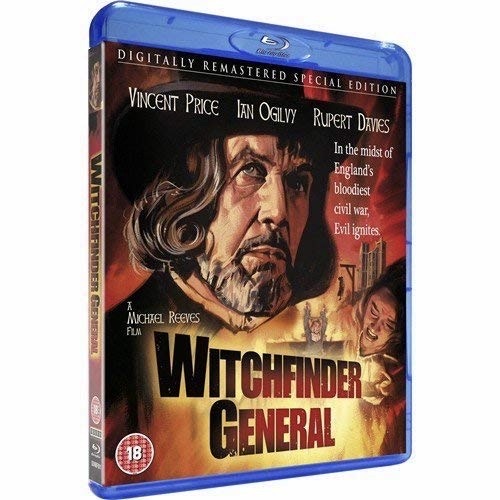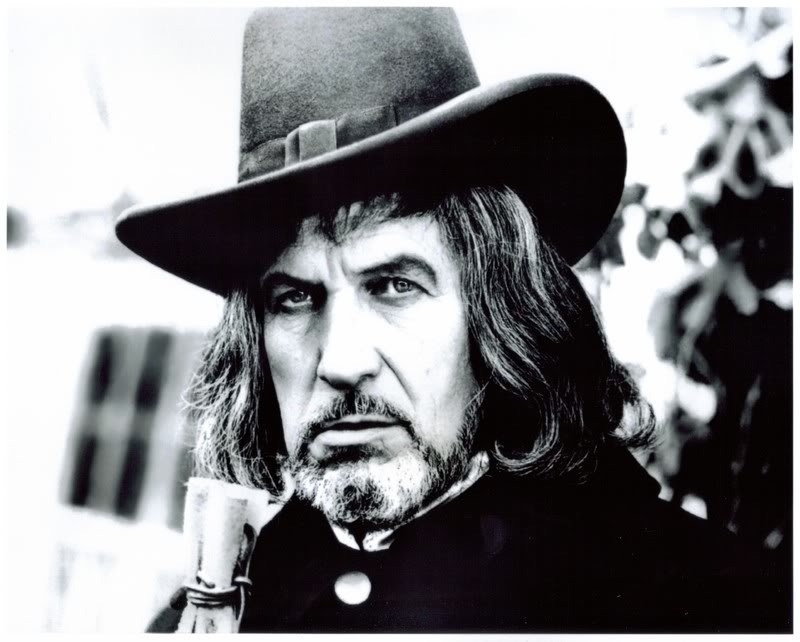
Vincent Price has always been associated with the horror genre even though he appeared in all kinds of other films during his career such as film noir (Laura), comedy (Champagne for Caesar), westerns (The Baron of Arizona), historical drama (The Private Lives of Elizabeth and Essex), science fiction (The Invisible Man Returns) and more. But his particular brand of villainy in horror films tend to be almost tongue-in-cheek with a macabre sense of humor and campy flourishes as in House on Haunted Hill (1959), The Tingler (1959), Diary of a Madman (1963) or Theater of Blood (1973), to name a few. His performance as infamous witch hunter Matthew Hopkins in The Conqueror Worm, however, was something else entirely – a genuinely chilling portrayal that was like nothing else he had ever done or would ever do again. Even today the intensity of his evil is the stuff of nightmares and he seems to be channeling the malevolent spirit of Hopkins in what is still a timely snapshot of political and religious persecution in the 17th century.
Let us consider the setting: 1645. England is the midst of a bloody civil war between the Royalists led by King Charles I and the Roundheads under the command of Oliver Cromwell. It is a time of confusion and lawlessness, particularly in the backwoods villages and hamlets where the locals are uneducated and superstitious. Matthew Hopkins, the son of a Puritan minister and Loyalist supporter, takes advantage of this situation, riding from village to village with his assistant John Stearne, to investigate any accusations of witchcraft by the residents. Using torture to extract confessions from the accused, Hopkins and Stearne were said to have executed over 200 “witches” between 1645 and 1646 before their methods were outlawed by magistrates under the new political order. Hopkins died of natural causes in 1647 after writing The Discovery of Witchcraft, a defense of his career. Stearne, who retired in 1648, also wrote a book about his beliefs, A Confirmation and Discovery of Witchcraft, but neither man was ever punished for their atrocities which were committed primarily for political and financial gain (they were paid for their “work”).
Centuries later, Hopkins and Stearne would finally receive their just desserts in director Michael Reeves’s revisionist historical thriller, The Conqueror Worm (1968, it was first released in England as Witchfinder General). The film was based on a historical novel by Ronald Bassett entitled Witchfinder General and adapted to the screen by Tom Baker and Michael Reeves. One of the few films to address this dark period in English history, Witchfinder General was produced for the exploitation horror market but Reeves’s intentions were clearly more than just jolting audiences in their seats with sadistic scenes of violence. Hopkins’s sinister presence dominates the film and infects every character so that by the end – even the nominal hero and heroine of the story (played by Ian Ogilvy and Hilary Dwyer) – have been reduced to a base and demented state. The scenes of innocent people being accused and tortured for witchcraft rises in intensity as the film progresses until it reaches a ferocious, ax-hacking finale where Hopkins and Stearne finally receive their due. But Reeves offers the audience no pleasure or relief because the avenger has been reduced to Hopkins’s level and is just as brutal and depraved.
The Conqueror Worm was only Michael Reeves’s third film and, unfortunately, it would be his last; he died from an overdose of sleeping pills mixed with alcohol the following year. Yet, based on the three films he left behind, the young director had a dark and uncompromising view of the world. In The She-Beast (1966), The Sorcerers (1967) and Witchfinder General, human nature is presented as something where good qualities are eventually overcome by man’s innate evil. Of the three, however, Witchfinder General is the most accomplished and the one that justifies Reeves’ cult status. In it, Vincent Price gives what many people feel is his most focused dramatic performance – he is truly frightening. His broad, theatrical style and tendency toward self-parody is absent here due to Reeves’ insistence on a quieter, more menacing mood. Reportedly, Price intensely disliked working with Reeves and making this film but even he admitted that the final result was impressive despite the methods Reeves used to achieve it.

The Conqueror Worm also benefits from the stunning cinematography of Johnny Coquillon which juxtaposes the tranquil English countryside against the abominations being committed there. Adding another ironic touch is the lush, romantic music score by Paul Ferris (it was replaced with one by Lex Baxter in the American release) which suggests a period Western. Reeves, in fact, remarked during the filming that he saw The Conqueror Worm as a western in the style of a Budd Boetticher film. Like Randolph Scott’s revenge obsessed protagonists of Ride Lonesome (1959) and Comanche Station (1960), Ian Ogilvy’s Richard is on a similar mission but one which ends in a much bleaker resolution than any Boetticher western ever did.

When American International Pictures, which had partially funded Reeves’ film and insisted on the casting of Vincent Price, distributed it in the U.S. under the title The Conqueror Worm, it was marketed as a horror film in the style of the other AIP Vincent Price/Edgar Allan Poe thrillers but with an added prologue and epilogue featuring Price reading passages from Poe’s poem of the same title.
In most markets, it was paired with the co-feature, The Young, the Evil and the Savage, an Italian giallo directed by Antonio Margheriti, and relegated to the drive-in circuit and grind houses. As a result, it was barely reviewed by any prominent film critics and when it was, the verdict was overwhelmingly negative due to its overt violence and disturbing subject matter. It wasn’t until almost a decade later that The Conqueror Worm was reappraised and recognized as one of the most striking British films of the sixties.
The making of The Conqueror Worm is just as fascinating and compelling as the film itself: American International Pictures entered into a film deal with Tigon Films and its production head Tony Tenser in order to take advantage of their contract with Vincent Price. Writer Louis M. Heyward, who worked for Tenser, recalled “It became part of my edict to find things for Vincent to do. We were coming to the end of Vincent’s contract and I was able to make a deal for less than $150,000…The attractive thing about the picture [The Conqueror Worm] was the price.”
Director Michael Reeves wanted Donald Pleasence to play Matthew Hopkins because he was much closer physically to the Hopkins in Bassett’s novel, but AIP, the American distributor and co-financer of the film, insisted that Vincent Price play the title character, and Reeves was forced to accept the decision.
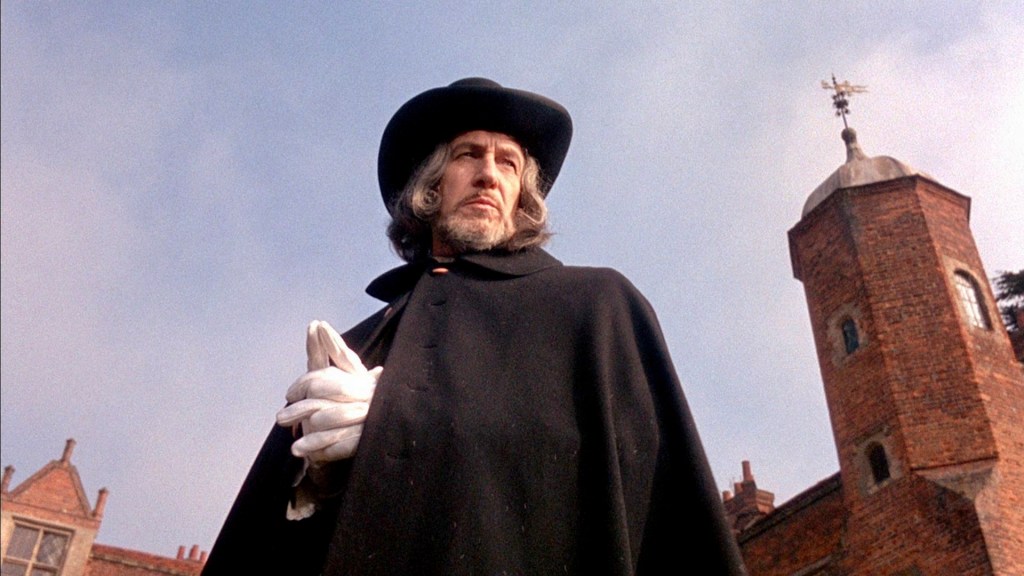
When Philip Waddilove, one of the producers of The Conqueror Worm, first met Vincent Price at the airport at the start of filming, the actor said to him, “Take me to your goddamn young genius.”
“When I went on location to meet him [Michael Reeves], Vincent Price recalled in an interview with Tom Weaver, he said, “I didn’t want you and I still don’t want you, but I’m stuck with you!” That’s the way to gain confidence! He had no idea how to talk to actors.”
“On the first day of filming,” according to Denis Meikle (in Vincent Price: The Art of Fear, “Price fell heavily from his horse and was temporarily bedridden. Reeves refused even to pay lip-service to his lead actor’s misfortune, which caused Price more hurt to his pride than the horse did to his coccyx. The relationship between the two soured from that point, though the absence of bonhomie paradoxically extracted from Price one of his most assured performances.”

Location scenes for The Conqueror Worm were filmed in Suffolk, England. Price and the rest of the cast and crew were also subjected to cold and wintry weather for most of The Conqueror Worm‘s exterior filming. Reeves’s brusque directing style didn’t endear him to anyone and he would often bark at Price, “Don’t move your head; don’t throw your voice.” Price would reply, “Very well. Not moving head – not throwing voice.” At one point Price got so incensed at Reeves that he challenged him, asking “Young man, I’ve been in 84 films. How many have you made?” Reeves responded, “Two good ones.” Price was so astonished at the young director’s unflappable confidence that he laughed heartily. (There are numerous variations of this story with slightly different exchanges between the actor and director).
Diane Ogilvy, co-star Ian Ogilvy’s wife at the time, recalled an incident that occurred as she was driving from the set after a day’s filming. Seeing Price sitting dejectedly nearby, she offered to give him a lift. “Are you going past California?” he enquired in reply. (from Vincent Price: The Art of Fear by Denis Meikle).
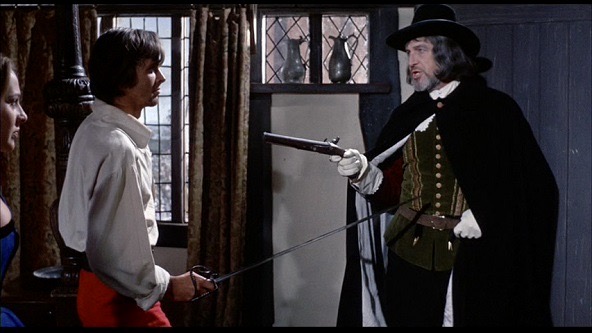
AIP pressured Reeves to add some sex and nudity to improve its box office chances in America. He reluctantly complied and filmed a nude lovemaking sequence with actress Hilary Dwyer and Ian Ogilvy. Reeves assured her that little would be revealed since he was shooting the scene with a dark blue filter. When Dwyer saw the film, however, she was appalled – “Oh god, what’s my mother going to say?” Despite her objections over the sequence, it is relatively discreet and her breasts are barely glimpsed.

In the climax when Richard kills Hopkins, Reeves instructed Ogilvy to repeatedly hit Price’s body hard with the rubber axe. It is certainly one of the most powerful scenes in the film and it was a grueling experience for Price who had to withstand the blows on a dank dungeon floor. It took Reeves more than 36 hours to capture the sequence and even then, he ran out of film and time. To add insult to injury, Price was later asked to re-dub his own voice to tone down his line readings.
Because the production schedule of The Conqueror Worm went overtime, Vincent Price was unable to make his previously planned cameo appearance in The Magic Christian (1969). He also was unable to appear in The Crimson Cult (1968) as planned, a horror film that would have reteamed him with Boris Karloff and Barbara Steele. His part, that of J.D. Morley, the master of Craxted Lodge, Greymarsh, was played by Christopher Lee.

British film censor John Trevelyan enforced edits of some of the more violent scenes in The Conqueror Worm despite Reeves’s objections. He reduced the number of ‘pricks’ inflicted on John Lowes (Rupert Davies) as Hopkins’ assistant searched for signs of the Devil; he shortened the witch burning sequence so we didn’t see the victim’s head and body enter the flames; Hopkins’ final death by ax mutilation was cut considerably despite the many hours Price had suffered during the filming of the scene. Even after these edits, the BCC reputedly refused to air The Conqueror Worm until additional cuts had been made.
After seeing The Conqueror Worm, Price wrote Reeves saying, “Congratulations! The contrasts of the superb scenery, and the brutality, the action the hero forces against the inexorable, almost pedantic inaction of the forces of evil, make for a suspense I’ve rarely experienced. So, my dear Michael, in spite of the fact that we didn’t get along too well, I do think you have a very fine picture, and what’s more, I liked what you gave me to do!” (from Vincent Price: A Daughter’s Biography by Victoria Price.)

Following The Conqueror Worm, Price returned to the U.S. and appeared in the short-lived Broadway musical comedy Darling of the Day. He also had a small role in the Elvis Presley film, The Trouble with Girls (1969) and then signed on for another Edgar Allan Poe adaptation, The Oblong Box (1969). At first Michael Reeves was slated to direct it but he died the month production began (another account states he was fired just prior to production) and was replaced by Gordon Hessler.
When Price heard the news about Reeves’s death, he said, “That poor boy! He was so talented and had such a bright future, but he was a deeply troubled young man. I realized only after I saw Conqueror Worm how talented he was. It was a great loss to the cinema. Had he been disciplined, he could have become a very good director. Believe me, this profession takes enormous discipline. You’re out there at six in the morning, and you’re up until midnight and back at six the next morning. There’s no fooling around if you want to last.” (from Vincent Price: A Daughter’s Biography by Victoria Price.)
Here is how various film critics responded to The Conqueror Worm:
“This ferocious low-budget period horror movie, an exploitation version of Arthur Miller’s The Crucible, is one of a small handful of pictures to touch on one of the major episodes of Western European history, the English Civil War and the Commonwealth…The film’s exteriors are flat, open, more agoraphobic than idyllic; the interiors have the cold, precise tone of Van Dyck…Vincent Price gives one of his most restrained performances as Matthew Hopkins..”
– Karl French & Philip French, Cult Movies
“…this portrait of backwoods violence….remains one of the most personal and mature statements in the history of British cinema…a fairly ordinary but interestingly researched novel by Ronald Bassett, with a lot of phony Freudian motivation, is transformed into a highly ornate, evocative, and poetic study of violence, where the political disorganization and confusion of the war is mirrored by the chaos and superstition in men’s minds. The performances are generally excellent, and no film before or since has used the British countryside in quite the same way.”
– Daniel Pirie, TimeOut Film Guide

“The torture and degradation inflicted by the witchfinder is part of an evil that pervades the social fabric itself, chronicled coolly in all its unsavory details by Reeves’ camera. The colours of death and decay imbue the movie with a muted but eerie intensity, relentlessly building up to the explosion of unconscionable violence…but rarely has violence been used so legitimately.
– Phil Hardy, The Encyclopedia of Horror Movies
“The Conqueror Worm is a stunning film in many ways, but probably Reeves’s greatest achievement is that he was able to maintain an extraordinary momentum throughout, until the film ends as it began with a woman…screaming…The audience never gets a chance to relax. By the end of the film it is as if you have just run the gauntlet.”
– Danny Peary, Cult Movies
“Savage, stylish minor horror melodrama with a growing reputation as the best work of its young director. Not for the squeamish despite its pleasing countryside photography.”
– Halliwell’s Film & Video Guide

“Price is brilliantly restrained…Splendidly evocative photography and an intelligent script that perfectly contrasts the lush green countryside with the grisly violence of Hopkins’ reign makes this one of the finest horror films of the ’60s.”
– James O’Neill, Terror on Tape
“..an extraordinarily bleak story of political evil…the movie has a robust autumnal quality perfectly matched by Price’s overripe performance. Witchfinder General bears the mark of its period-there’s an overabundance of zooms and an easy reliance on the brutality of brightly hued gore-but it remains contemporary, and even frightening, in its evocation of cynical Puritanism and mass deception.”
– J. Hoberman, The Village Voice
“Price is an excellent heavy, but while sometimes he seems to piously believe he is rooting out witches, most of the time he’s simply killing for the fun of it, and some money….Ogilvy is somewhat dashing, but has a one-note hero’s role to play. Dwyer gives evidence of acting talent, but she and all principals are hampered by Michael Reeves’s mediocre script and ordinary direction.”
– Variety

“..a grim portrait of pre-totalitarian violence, following 17th-century torturer Vincent Price on a righteous tear through Norfolk. The landscapes are evocative, and the gist misanthropic.”
– Michael Atkinson, The Village Voice
“Price delivers perhaps the best performances of his career. Rather than his usual campy villain, he plays the role straight, exuding an air of sadistic menace. Reeves directs impressively. His style – mobile camerawork, with judicious use of zooms and close-ups – owes little to Hammer horror. He displays a good feel for the landscape, contrasting a tranquil nature and a violent humanity…From the opening to the closing credits, Reeves depicts every brutality unflinchingly. But with justification. He wanted the violence to disgust rather than excite, and succeeds. Reeves’s take on the human condition is unrelentingly bleak.”
– Keith H. Brown, Edinburgh University Film Society

“Time has not diminished the raw power of Witchfinder General. Its perfect historical setting, beautiful camerawork and unflinching portrayal of something we’d all rather not think about ever having happened sets it apart as quite possibly the greatest British Horror Film ever made. High praise indeed, but without a doubt deserved.”
– http://www.britishhorrorfilms.co.uk/
“One of the most in-your-face films ever released – or should that be unleashed? The movie’s bleak and unrelenting violence caused such a stir back in 1968, and remains strong stuff even by today’s standards. Director Reeves pulls no punches in telling a story of surface simplicity but vast political and historical interest. It’s also arguably the closest approximation to the classic Western ever made in the British Isles, and one of the most remarkable cinematic treatments of that country’s wilder landscapes…Reeves’ approach is occasionally crude: his use of incidental music is especially heavy-handed (though Paul Ferris’s score is generally excellent). But the directorial techniques are entirely appropriate given the extreme nature of this material and the fact that Reeves is deliberately echoing and critiquing ‘traditional’ British horror movies. He was also the only director ever to draw a totally straight performance from Price.”
– Neil Young, www.jigsawlounge.co.uk

“The Conqueror Worm…stars Vincent Price and features any number of attractive young aspiring stars who seem to have been cast mainly for their ability to scream. Scream as though they were being slowly burned to death, or kicked, or poked, or stabbed – mainly about the eyes – with sticks, or shot through, or otherwise tortured, which, in fact, they are. Vincent Price has a good time as a materialistic witch-hunter and woman-disfigurer and dismemberer, and the audience at the dark, ornate New Amsterdam seemed to have a good time as well.”
– Renata Adler, The New York Times.
“The ending is indeed shocking (the protracted scream that almost closes the movie is definitely well-earned), but it is also terribly sad as well; it is almost no surprise that the soundtrack to this movie foregoes an air of horror in favor of an air of bitter sadness and loss….this bleak horror film packs a punch that will not soon be forgotten.”
– www.scifilm.org
Witchfinder General is no masterpiece, but Reeves’ propitious use of picturesque Suffolk countryside in autumn light, and his employment of extant locations in Hopkins’ historical killing-field of Brandeston (though not Lavenham, as depicted) invest it with a breath of vision which belied its meagre 83,000 pound budget and echoed clearly of the Western myth – of Delmer Daves, and John Ford and Monument Valley – which Reeves was at pains to evoke. It is elegiac, as well as being ripe with symbolism.”
– Denis Meikle, Vincent Price: The Art of Fear.

Additional trivia about The Conqueror Worm:
The real Matthew Hopkins rose to power in March of 1645 by accusing an elderly woman named Elizabeth Clarke of witchcraft. She was dunked in water until she confessed which resulted in 32 suspects being arraigned in Chelmsford Assizes. He later traveled to Suffolk with his assistant John Stearne where he accused the local pastor, John Lowes, of witchcraft. The suspect was subsequently hanged. In Bassett’s novel, Hopkins eventually meets his demise at the end of a rope but in real life he died of tuberculosis in 1647 in Manningtree, Essex.
Michael Reeves was only eight years old when he began telling friends he wanted to make movies.

Writer Tom Baker recalls that he and Reeves began making movies as teenagers using an 8mm Bolex and a tea trolley for tracking shots.
Reeves first met Ian Ogilvy at the age of fifteen when they were both classmates in high school. Together they made a 20 minute film called Carrion in which Ogilvy played a psychopath terrorizing a crippled girl.
Ian Ogilvy would end up playing the lead in all three of Reeves’s films – The She-Beast (1966), The Sorcerers (1967) and The Conqueror Worm.
Before he turned twenty, Reeves and his mother inherited a family trust fund that enabled him to travel to America where he sought out his idol, director Don Siegel. He found out where Siegel was living in Hollywood, went to his front door, rang the bell and introduced himself. Siegel was impressed enough to get him an entry level job at a studio, running errands and attending to minor production details.
Through family connections Reeves knew producer Irving Allen who helped get him hired on the film crew for The Long Ships (1963), a Viking adventure starring Richard Widmark and Sidney Poitier, that was filmed in Yugoslavia.
Producer Paul Maslansky met Reeves during the making of The Long Ships and was so impressed with him that he hired him as second unit director on his upcoming production, Castle of the Living Dead (1964) starring Christopher Lee.
The association with producer Paul Maslansky led to an opportunity for Reeves to direct his first feature film. Working with a low budget in Italy, Reeves directed his friend Ogilvy and Barbara Steele in The She-Beast. Steele, the only high profile name in the cast, was hired for one day’s work at $1,000 but, because she was not-SAG and the crew was not union, she was bound to work 18 hours straight. She had no choice but to comply but she was so angry she didn’t speak to Maslansky for years afterwards.
Exploitation producer/distributor Tony Tenser first worked with Reeves when he was presented with a deal by fledging producer Patrick Curtis (he played Baby Wilkes in Gone with the Wind, 1939) to make The Sorcerers starring Boris Karloff, Catherine Lacey and Ian Ogilvy.
The box office success of The Sorcerers convinced Tenser to co-produce The Conqueror Worm for Reeves with some financial involvement from American International Pictures who insisted on casting Vincent Price.
The film is also known as Edgar Allan Poe’s Conqueror Worm.

“Michael Reeves, the director, wanted me to play it absolutely cold, without emotion of any kind,” Vincent Price revealed in an interview in Video Watchdog. “We didn’t get along at all, but I agreed with what he wanted. I think I understood what he wanted. I think it’s one of the best performances I’ve ever given, and I think it is a classic picture of its kind.”
All British versions of The Conqueror Worm prior to 1996 were cut by 1 min 26 seconds by the UK censor on the original release. The Redemption Video release restores this material from European laserdiscs. (from IMDB)
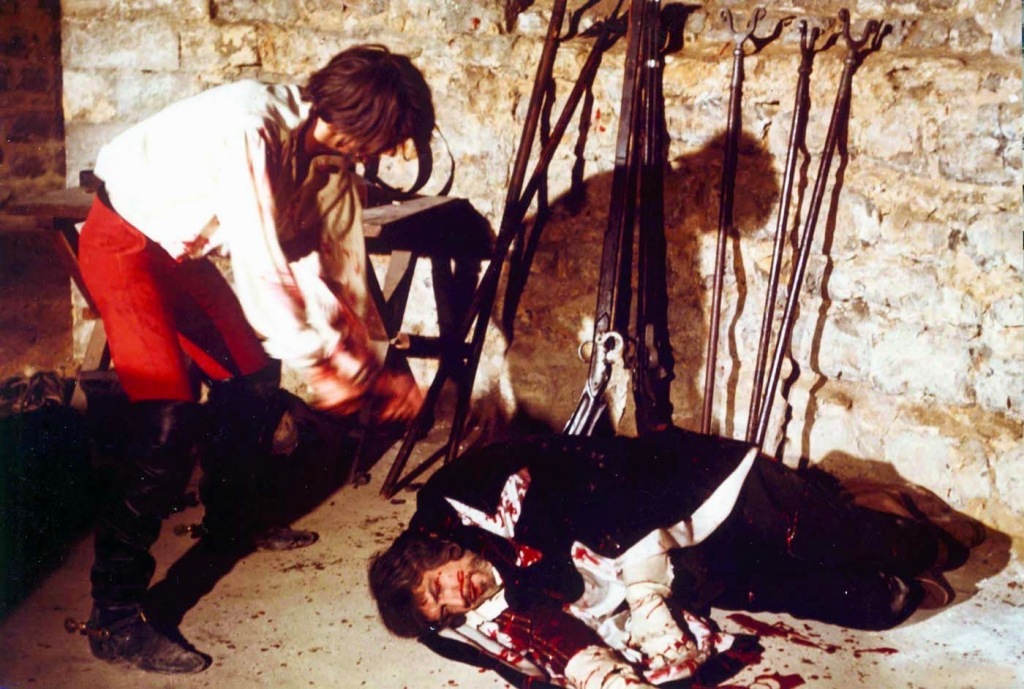
The UK R2 DVD features 2 versions of the film – the original UK version (labeled “The Director’s Cut”, with BBFC censor cuts restored via grainy, inferior quality inserts) and the Continental version (labeled “The Export Version”) that has alternate takes of several tavern shots in which the various wenches are topless or have exposed breasts; in the UK version they are more conservatively dressed and there are extra scenes of torture and violence, notably additional axe blows to Price’s body at the film’s conclusion. (from IMDB).
Regarding the gory finale, Ivan Butler wrote in Horror in the Cinema, “The real horror of Matthew Hopkins is that he died in his bed. Had he met the end given him here one could comfortably feel that at least he had received his due.”
The American version, retitled The Conqueror Worm, features opening and closing narration from Edgar Allan Poe’s poem of the same name.
Tigon promoted the film in England as “The Most Violent Film of the Year.”
When the film was first released in England, it was denounced by most critics for its sadism though a few praised it for its historical insight. One of the film’s biggest detractors was playwright Alan Bennett (on the staff of The Listener) and its two most vocal supporters were Tom Milne (writing for Monthly Film Bulletin) and Robin Wood (critic for Movie).
Although women accused of witchcraft are burned alive in The Conqueror Worm, in English history and Bassett’s novel, people accused of being witches in England were hanged or drowned during “tests” of their guilt.

The USA version, titled The Conqueror Worm, as well as having the reference to the Poe poem, replaces the film’s original score by Paul Ferris with a different score by Lex Baxter. UK prints under the title Witchfinder General have the correct original Ferris score.
John Coquillon, the cinematographer of The Conqueror Worm, would eventually work with Sam Peckinpah on four films including Straw Dogs (1971) and Pat Garrett and Billy the Kid (1973).
Robert Russell was re-voiced in the film by Bernard Kay.

Wilfrid Brambell, who has a brief cameo role in The Conqueror Worm as Master Loach, played the grandfather of Paul McCartney in the Beatles’ debut film, A Hard Day’s Night (1964). He specialized in eccentric character parts in British movies such as Crooks in Cloisters (1964) and also appeared in two Disney features, In Search of the Castaways (1962) and The Three Lives of Thomasina (1964).
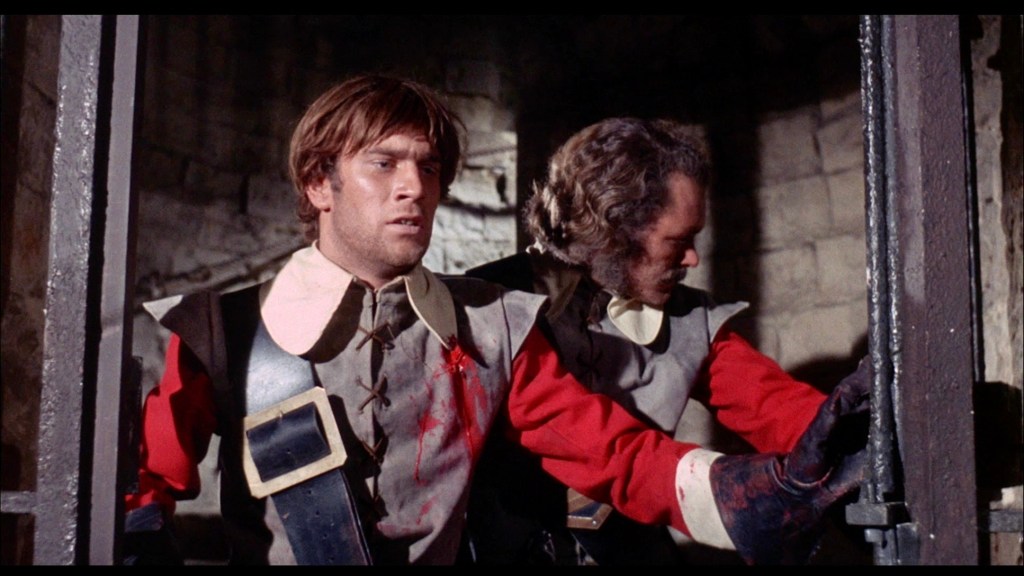
Nicky Henson, who plays Trooper Swallow in the film, appeared in numerous British films including the Peter Sellers-Goldie Hawn comedy, There’s a Girl in My Soup (1970), Vampira (1974) and The Bawdy Adventures of Tom Jones (1976). His most memorable part, however, may be the motorcycle gang leader who returns from the dead in the offbeat black comedy, Psychomania (1971).
Patrick Wymark, who has a brief scene as Cromwell in The Conqueror Worm, also appeared in another period thriller that enjoys a cult following, The Blood on Satan’s Claw (1971), a tale of a teenage devil coven that preys on an isolated rural village.

Tony Tenser and Michael Klinger, the owners of Tigon, the distributor for The Conqueror Worm, Reeves’s earlier The Sorcerers and other exploitation films, were responsible for financing Roman Polanski’s first two English-language films, Repulsion (1965) and Cul-de-Sac (1966).
Following the release of The Conqueror Worm, Reeves tried to launch several new projects but each one fell through, leaving him depressed and withdrawn. He began drinking heavily and taking drugs which apparently was the cause of his sudden death at the age of 24; it has never been proven whether it was suicide or an accidental death.
*This is an expanded and revised version of articles about The Conqueror Worm that originally appeared on the Turner Classic Movies website.
The Conqueror Worm has been released on the VHS and DVD format over the years but it was hard to see the original uncut, British version until June 2011 when Odeon released an attractive multi-format disc of it under the title Witchfinder General featuring numerous extras. Even better is the remastered version of the film on Blu-ray in The Vincent Price Collection from Shout! Factory (released in September 2020) which includes a host of new extra features such as a commentary track by actor Ian Ogilvy and producer Philip Waddilove.
Other links of interest:
http://www.screenonline.org.uk/people/id/507493/index.html
https://www.historic-uk.com/HistoryUK/HistoryofEngland/Matthew-Hopkins-WitchFinder-General/


